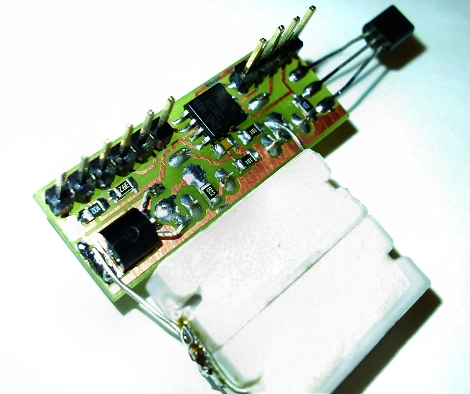
[Manekinen] built a power supply monitor based around an AVR ATtiny13. Voltage and amperage are displayed on a 16×2 LCD character display (we’re not sure what the third number is… samples per second?). This is no small feat considering that the tiny13 is an 8-pin chip. He makes it happen by using the pins for both LCD control and ADC input. To make this happen the HD44780 compliant display is used in 4-bit mode. Check out the video after the break and hit up the non-translated page if you want to download the source code and PCB artwork. A note of warning, he’s using the RESET pin for I/O which means once you burn the fuses you’ll need a programmer that has High Voltage Serial Programming capabilities if you want to reprogram the chip.[youtube=http://www.youtube.com/watch?v=7n9F4LuwhvM]
[Thanks RicoElectrico]














My guess is the 3rd number is the temperature as read by the LM35…
*gets big stick*
s/amperage/current/
:o)
cool. I bet that was really cheap to build too.
Yea definitely temperature in Celsius.
Good job on the hack. I’ve been using those LCDs in nybble mode quite a bit, freeing up 4 IO pins, even on a 20 pin device, is a huge improvement. I see no reason to use 8 pins :S(but I sure there are apps that need all 8)
you only need all 8 pins if you are using custom graphics or fonts. 99.9978% of the time 4bit is perfectly fine.
99.9978%… he he…
A very nice job!
@Sheldon: I was wondering about that myself, though had put it down to an Americanism (see also “wattage” instead of “power”). I guess we generally say “voltage” instead of “potential difference” in the UK, though… :-P
@fartface: You don’t even need all 8 for that. You can do absolutely everything nibble-wise that you can do byte-wise. The only reason you’d use all 8 pins is for simplicity of the driving software – splitting your data up into nibbles and sending them one at a time is too much for some people apparently!
8 bit is just faster, but who needs to be fast to write to an lcd
Why an ATtiny13? First it’s obsolete and often ATMegas are cheaper. Then you don’t get cramped for pins. Please not another 7805 regulator. This is 2010 for crying out loud. Nicely done otherwise.
There should be a pin to trigger a MOSFET switch or relay at a settable current level for protection.
Now to take it to the next step. Make a bench power supply using an old PC power supply and a variable regulator. This little device would make a cheap and easy Volt-Ammeter-electronic fuse. Would be good for a battery charger/monitor too.
You can get 2×16 HD44780 LCDs without backlight for around $2,00 USD each in unit quantity on ebaY for example.
Wheeee…
@Drone: “Please not another 7805 regulator. This is 2010 for crying out loud.”
please do point me/us in the direction of suitable alternatives.
OK vim, I’ll shoot. A switcher for hobbyists: the National LM2574 is available in 8-pin DIP, is second-sourced by On Semiconductor, and is almost as easy to use as a linear regulator. Just follow the instructions in the data sheet and maybe read National’s app note on laying out PCBs for their “Simple Switcher” chips. Avoid solderless breadboards and build prototypes dead-bug style with short connections.
Brent: thanks!